Saturday 19 – Friday 25 September 2009 Mahendranagar - Lumpini – Tansen
As we'd been told that the area had been a real Maoist stronghold and as it was already dark and very sticky and humid we decided to splash out on a guest house room for our first night in Nepal. We ended up at the "Hotel Sweet Dream" one of a stretch of little hotels very close to the border. They had actually allowed us the option of parking and sleeping in the car, and when we got to the room it was like a furnace as it'd been shut up for a while so on balance the car might have been more comfortable!
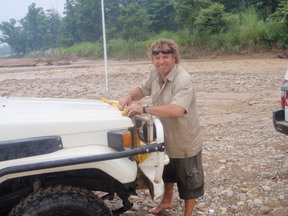
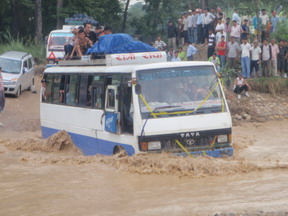
Anyway we woke reasonably refreshed the next morning. Nepal immediately had a different feel to India we both agreed though it was hard to put your finger on exactly what that was. In many ways it remained us of Laos - it was around the same season as when we were in Laos and the rice was green and it had the same laid back rural ambience. Like Laos there was also a widespread profusion of beers. As mentioned before in India getting a drink out of touristy areas can be a bit "cloak and dagger" as on the surface anyway, drinking is frowned on there, but in Nepal there is a huge range of local beers: Everest, Nepal Ice, Gurkha to name a few. We will provide updates on the qualities of each as we go!
We had a quick look around town - lots of markets and money changers same same as border towns everywhere - and set off heading east down Mahendranagar Highway or Highway 1. This highway has long had a bad reputation as being a centre of attacks on bridges and government buildings by Maoist rebels. Whilst the Maoists have publicly stated that they mean no harm to foreigners and are happy to welcome tourists they allow that it is possible visitors may be caught in the crossfire of their actions. Fortunately we had no problems whatsoever in this regard. Instead the forces of nature gave us a few sticky moments!
It was now the end of the monsoon season meaning that everywhere the paddy fields were green and lush. Sadly it also meant that the journey was a long catalogue of collapsed bridges muddy roads and resultant delays. Actually we didn't fare too badly at all once we changed to 4 wheel drive and our RAW shocks and Maxxis tyres kicked in, but we did have to do one slightly dicey river crossing. When we got there traffic was backing up and the river was very swollen and flowing very fast. The big buses were packed with every inch of roof space taken (very like Cambodia) and it was a bit hairy seeing them up to the windows with water. Incidentally travelling on the roof is illegal here due to the high number of casualties though you wouldn't know it!
We put the tarpaulin on to protect the engine and got through in one go but the water came up to the level of my window. It was a bit scary as if you faltered or stopped the river could catch you and knock you off course and there were a few abandoned waterlogged vehicles to show this. On this highway we crossed around 44 rivers - with a variety of bridges of all shapes and sizes!
On the way we saw a few teams of loggers busy loading logs onto trucks - 20 odd guys pulling up each log of around 1 tonne. You wouldn't want to slip!

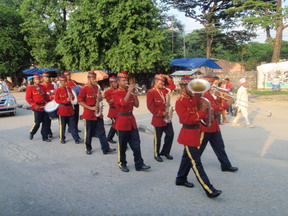
After this the roads improved and we drove on to spend the night in Nepalganj. This is another border with India and has the same "frontier" border town feel - lots of markets selling goods. It is also the site of a great deal of UN activity and like Cambodia UN vehicles were everywhere.
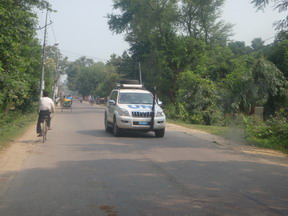

We camped in the garden of a fairly up market hotel. The next morning we awoke to find the car park full of UN cars (mainly land cruisers like ours but brand new not like ours!) and the dining room out of bounds as the UN reps were holding a breakfast meeting. Again this reminded us of Cambodia and we were concerned that the UN money was going to the right place. Sadly NGOs and corruption seem to go hand in hand! We met a Kiwi guy over here helping children directly to bypass all this red tape.
Anyway on we drove through race paddies and mountain roads to our next destination of Lumpini - a hugely important pilgrimage site as it is the birthplace of Lord Buddha in May of 563 BC.

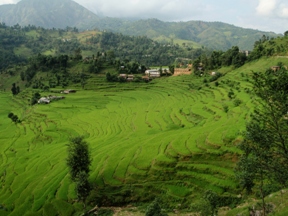
We have noticed so far that Nepal is much more camping friendly than India - I think as we get closer to the "overland" route from Europe they are increasingly used to vehicles like ours and the hotels seem to have a camping area set aside. At around $7 Aus a night for the car it's more than we're used to paying - but we can't really complain!!
We camped in the gardens of the palatial Buddha Maya Gardens Hotel but went down the road to the Lumbini Hokke Hotel for a Japanese dinner! The area has a lot of Japanese tourists (Japan being a predominantly Buddhist country) and we'd really missed Japanese food - not a biggie in India!
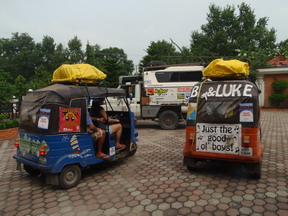

We were surprised to see a couple of Auto Rickshaws parked in the car park covered in stickers saying "Goa to Pokhara." We soon met the English drivers. The rally (over 60 vehicles in total) is organized by a UK based adventure company. How it works is you pay a fee to compete - this gets you your rickshaw some initial driving lessons and insurance. After this you are your own - all you have to do is get from Goa to Pokhara - hopefully in time for the big party at the end. You also have to raise a minimum of 1,000 GB pounds which all goes to charities in Nepal and India.
Once in Pokhara the vehicles have a short rest (!!) before the next group of intrepid travellers arrive to drive them back again. The same company organize similar events around the world. It looked hard work but great fun- and all for very good causes (prevention of child trafficking being the main one this time.) Have a look at their site to find out more http://rickshawrun09.theadventurists.com
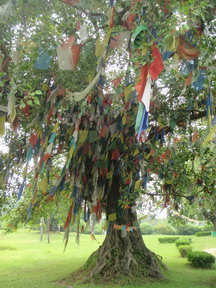

So next morning we were up bright and early to suss out where Buddha started out! We weren't allowed to take our vehicle into the main park and as the sites were quite spread out we walked a lot - though we cheated and got a cyclo rickshaw for some of it!!

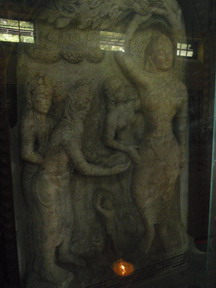
As a major pilgrimage site Lumpini isn't too full on like some of the Indian ones were but there has been a huge amount of money poured in here with monasteries built by Japan Thailand Germany and France amongst others. The faithful come to pay their respects and stay on to meditate.
Lord Buddha was born beneath a tree when his mother stopped to bath in a beautiful lake whilst on a journey and went into labour. The actual site of the birth is now within the Maya Devi Temple. This contains excavations of various ruins marking both the spot of the birth and later monuments set up to commerate that i.e.) a 14th century carved relief showing the miraculous birth.
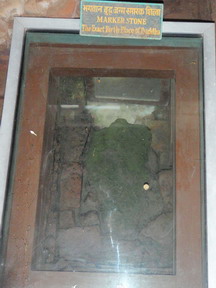

The actual site of the birth was marked with a stone - you can walk on a platform set around the ruins and view it.
The temple and surrounds is obviously a very important site to many pilgrims and around the trees and gardens people were receiving blessing from monks.
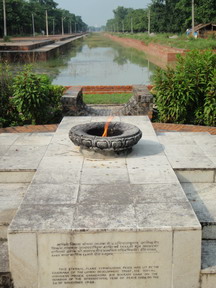
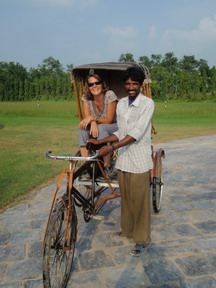
We then headed to the Western and Eastern Monastic zones - which are the sites of various monasteries - the West starting with an Eternal Flame.




This was very spread out and it was very hot so here we got on a cycle rickshaw. The Western zone housed the very ornate Great Drigung Kagyud Lotus Stupa - built by the German Tara Foundation - with some gorgeous murals in the main prayer room and a lot of statues set in landscaped gardens.
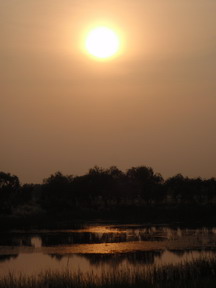
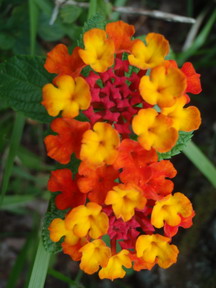
We walked home seeing a gorgeous sunset over the lotus ponds- it was a very attractive setting flowers and butterflies everywhere.


The next day before leaving we headed to the Japanese World Peace Pagoda which we'd missed out the previous day. This gleaming white stupa was constructed in 1993 one of a series to commerate world peace. It allegedly cost Japanese Buddhists over $1 million USD! It was certainly pretty ornate - all marble and gold. Sadly it was very overcast that morning and so you don't get the contrast with the white and the blue skies we'd have got the day before.
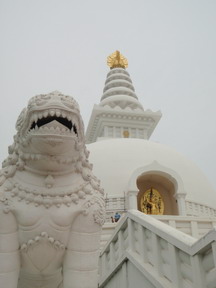
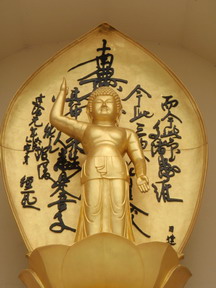
On we drove towards our next destination the little hill town of Tansen. The drive rose steeply up the mountains - all very picturesque lots of rolling hills tiered rice paddies and mountain streams. We kept passing auto rickshaws and sure enough when we arrived at our camping spot for that night - the Hotel Srinagar - there were half a dozen of them already there. The local kids were entranced and with all these foreigners arriving in strange vehicles!
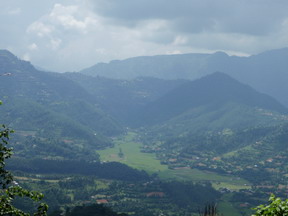
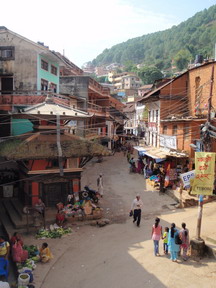
The hotel staff were very welcoming and thankfully acted as security to help keep away the hordes of kids without which we'd not have had a second's peace! We went for an explore next morning. Tansen was a lovely little town - not too touristy it retained a traditional air and the people were very friendly.

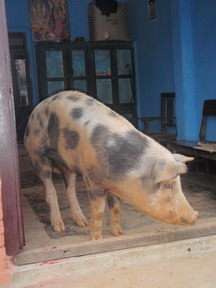
We walked down through the hilly streets with smiley children and …pigs in the houses on some occasions!!! The central square had some lovely traditional Newari (a tribal people of Nepal) architecture and a little market square selling fresh vegetables.

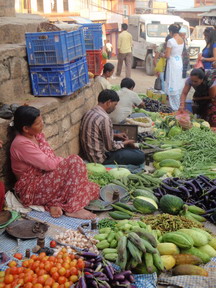
We also saw a mobile Betel Nut store - though chewing it doesn't' seem as prevalent here as Myanmar or India.
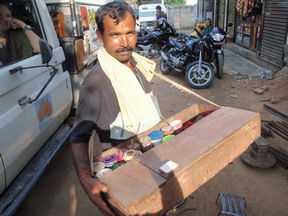
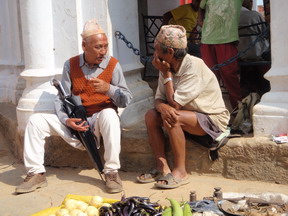
Tansen is a big centre for weaving and most of the older men wore the traditional multi coloured Nepalese woven hats or Dhaka Topi.
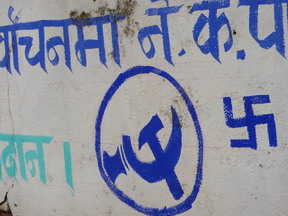
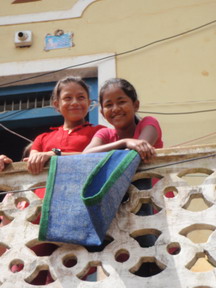
The area seemed very friendly but it was the scene of a lot of trouble just a few years ago - in 2006 the central palace of Durbar (which was a government HQ of some sort) came under attack from the Maoists and was totally destroyed. They are now rebuilding the ruins from scratch. The fighting that followed killed over 20 people - no one could (or wanted to) give us precise details. Looking at local graffiti you still see the Maoist emblem everywhere so the party obviously still has a groundswell of local support.
There is another palace called the Ranighat Durbar - somewhat fancifully described in the brochures as the Taj Mahal of Nepal . Whilst it was only 7km out of town the road was shut due to landslides so we didn't make it.
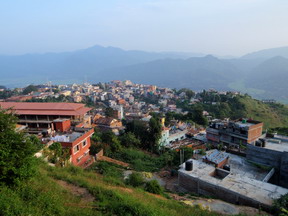
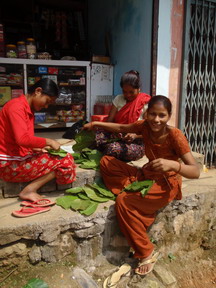

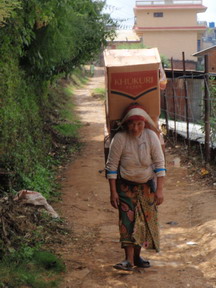
We went on a walk up to the Shreenagar Danda the 1600 metre hill overlooking the town. The way up was a bit steep in the heat but once we got up to the top - near a Buddhist shrine - the view over the surrounding hills and down over the town was spectacular, though we couldn't see the Annapurna mountain range which you can on a perfect day.

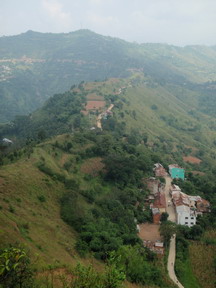
We then enjoyed a traditional Newari meal at Nanglo West a local restaurant. This feast had a variety of dishes - choylo (dried buffalo with chili and ginger) chura (flattened rice) and spicy potato in curd. Absolutely delicious!

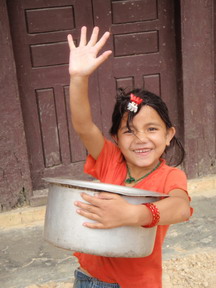
That day we went to try and get a new SIM card and realized we'd left it too late. Research had told us that getting a Government SIM card from the Nepal equivalent of Telstra (or BT) was the most reliable way to go so we headed to the Telecommunications Department. That's when we found out that the festival of Dasain had just started. This is the most significant of the year in Nepal and it lasts 15 days during which time all Government departments shut down! The festival is one in which people try and spend time with their families and as many Nepalese work away from their villages this puts huge pressure on the buses - hence the overcrowding we'd witnessed. No phone card for us for a little while!
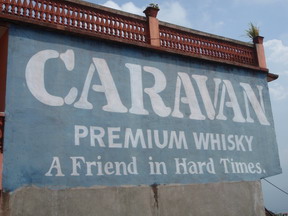

So on Friday 25 September we drove through winding roads with lovely mountain views - increasingly full of auto rickshaws!! - to arrive in the early evening at the beautifully set mountain and lakeside city of Pokhara.
